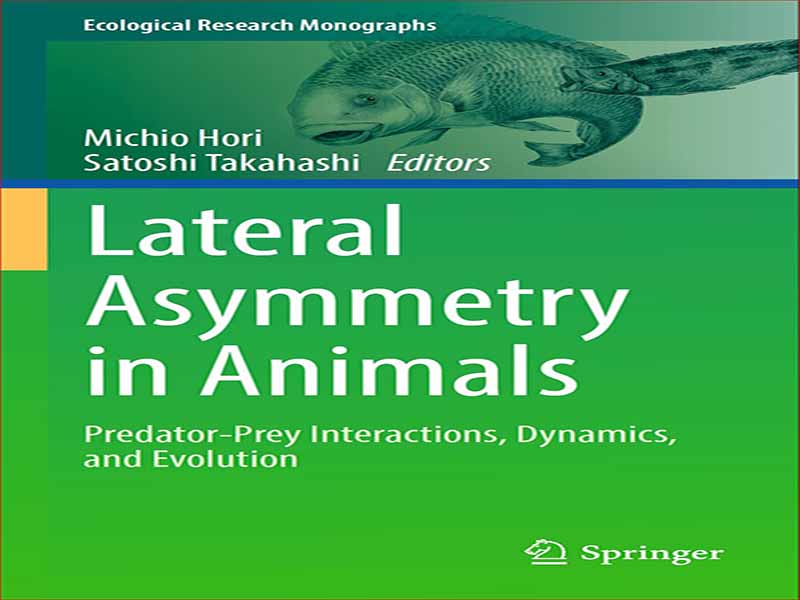- عنوان کتاب: Lateral Asymmetry in Animals
- نویسنده: Yuncai Wang
- حوزه: زیست محیطی
- سال انتشار: 2022
- تعداد صفحه: 301
- زبان اصلی: انگلیسی
- نوع فایل: pdf
- حجم فایل: 22.5 مگابایت
این کتاب به بررسی مطالعات اخیر، عمدتاً ما، در مورد جانبی ماهی و سایر حیوانات می پردازد. این مطالعات از کشف دهانه نامتقارن سیکلیدهای فلس خوار در یک دریاچه آفریقا شروع شد و به دوشکلی جانبی و رفتارهای مربوط به همه ماهی ها گسترش یافت و اکنون در نهایت به برخی از بی مهرگان آبزی نیز کشیده شده است. در طول مطالعات، ما اغلب سؤالاتی مانند “چرا ماهی چنین شخصیتی ایجاد کرد؟” دریافت می کردیم. و «آیا وقتی بدن متقارن و رفتارهای بیطرفانه دارند، میتوانند کارآمدتر عمل کنند؟» ما همیشه اینگونه پاسخ میدادیم که «در حال حاضر دلیل دقیق آن را نمیدانیم، اما فقط میتوانیم بگوییم که به نظر میرسید شخصیت را توسعه داده و حفظ کردهاند، زیرا برای زندگیشان مفیدتر بوده است. اتفاقاً ما فرض میکنیم که شما هم دست راستی یا چپی روشنی دارید، اینطور نیست؟» ماهیت قابل توجه جانبی بودن به گونه ای است که اکثر مردم با وجود حقایقی که همه به آن مقید هستند و همچنین این دوشکلی در هر جمعیتی در هر عصری با نسبت معینی حفظ شده است، آن را کم توضیح می دهند. از لحاظ تاریخی، جانبی عمدتاً بر روی دست بودن انسان، به عنوان ویژگی منحصر به فرد آن، مطالعه شده بود و به جانبی شدن مغز مربوط می شد. تعداد زیادی مقاله، کتاب و حتی یک مجله بین المللی مخصوص عدم تقارن جانبی منتشر شده بود. پس از آن، مطالعات روی حیوانات بر روی پستانداران، به ویژه بر روی پستانداران غیر انسانی و حیوانات آزمایشی (موش و موش) آغاز شد و سپس بر روی حیوانات همراه و/یا اهلی، پرندگان و سپس ماهیهای موجود در آکواریوم پخش شد. در این مطالعات، با این حال، جانبی عمدتا از نقطه نظر عدم تقارن رفتاری در رابطه با جانبی شدن مغز مورد مطالعه قرار گرفته است، اما عدم تقارن مورفولوژیکی به جز عدم تقارن در ساختار عصب مرکزی نادیده گرفته شد. این مطالعات عمدتاً از دیدگاه یک ویژگی گونه یا یک ویژگی فردی انجام شده است. در حالی که، این کتاب، با تمرکز بر ماهی ها و بی مهرگان آبزی، به رابطه عدم تقارن مورفولوژیکی با جانبی رفتاری می پردازد که عمدتاً توسط مطالعات اخیر ما روشن شده است. مطالعات ما بر تعامل بین گونه ای، به ویژه تعامل شکارچی-شکار در جامعه تأکید می کند و به انتخاب وابسته به فرکانس توجه می کند. ما همچنین در مورد رابطه فیلوژنتیک جانبی ماهی، و همچنین منشاء و وراثت آن، با حیوانات چهارپایان، و رابطه با بی مهرگان بحث خواهیم کرد. اگرچه تعدیل گسترده آثار ما با نتایج مطالعات مرسوم در آینده به عنوان موضوع باقی خواهد ماند، امیدواریم خوانندگان بتوانند از زمینه جدیدی از جانبی حیوانات لذت ببرند. به نظر می رسد نسبت جانبی مقیاس خوار در نوسان است، اما تفاوت از 0.5 معنی دار نیست. مطالعه من در مورد عدم تقارن جانبی با این کلمات استخراج شد. من (S.T.) اولین بار با پروفسور هوری در سمینار آزمایشگاه جامعه شناسی حیوانات آشنا شدم. در دانشگاه شهر اوزاکا، جایی که او در مورد عدم تقارن جانبی مقیاس خوار صحبت کرد. در آن زمان، من اولین موقعیت شغلی خود را در دپارتمان ریاضیات در O.C. U گرفتم و در حال مطالعه فراکتال ها بودم. به نظر میرسد که دادههای Hori از نسبت جانبی مقیاسخواران بین سالهای 1980 و 1990 با دوره 5 ساله نوسان میکند، اما تفاوت نسبت 1:1 برای هر سال معنیدار نیست. برای نشان دادن نوسان از دو جهت آمار و مدلسازی نزدیک شدم. اگرچه با بسیاری از روش های آماری آشنایی نداشتم، اما می توانستم احتمالات را محاسبه کنم. من دادههای نسبت جانبی سالهای مختلف را با تبدیل فوریه جمعآوری کردم و اهمیت آن را نشان دادم. این رویکرد آماری در فصل خلاصه شده است. 7 از این کتاب. روش دیگر برای اثبات نوسان، مدل سازی مکانیسم نوسان بود. ترکیب مزیت اقلیت دوشکلی جانبی در شکار و تأخیر زمانی دوره رشد 2 ساله در مدل مقیاس خوار، نوسان دوره ای 5 ساله نسبت جانبی آن را تکرار کرد. این رویکرد مدلسازی پویایی جمعیت در فصل خلاصه شده است. 5. از همکاری با پروفسور هوری، مشاهده حمله ترازو خوار به ماهی قرمز در تانک های آزمایشگاهی اش و غیره لذت بردم.
This book reviews recent studies, mainly of ours, on the laterality of fish and other animals. The studies started from a discovery of asymmetric mouth opening of scale-eating cichlids in an African lake, and extended to lateral dimorphism and corresponding behaviors of all the fishes, and now eventually stretches to some aquatic invertebrates. During the studies, we often received queries, such as “Why the fish developed such a character?” and “Could they act more efficiently when they have a symmetric body and unbiased behaviors?” We always answered such as “We don’t know the exact reason at present, but we can only say that they seemed to develop and retain the character as it has been more useful for their life. Incidentally, we suppose that you too have a clear handedness, as either righty or lefty, haven’t you?” The remarkable nature of laterality is such that most people make little account of it, despite the facts that everyone are bound by and also that this dimorphism has been maintained with a certain ratio in every population in every era. Historically, the laterality had been studied mainly on the handedness of human being, as its unique property, and had been related to the cerebral lateralization. A large number of papers, books, and even an international journal specific to the lateral asymmetry had been published. After that, studies on animals have been started on mammals, especially on non-human primates and experimental animals (the rat and mouse), and then spread over companion and/or domestic animals, birds, and then fishes in aquariums. In these studies, however, the laterality has been studied mainly from the viewpoint of the behavioral asymmetry in relation to the brain lateralization, but the morphological asymmetry was rather disregarded except the asymmetry in central nerve structure. These studies have issued mainly from a viewpoint of a characteristic of species, or a property of individual. Whereas, this book, focusing on fish and aquatic invertebrates, addresses the relation of morphological asymmetry to the behavioral laterality clarified mainly by our recent studies. Our studies put emphasis on interspecific interaction, especially predator–prey interaction in community, and pay attention to frequency-dependent selection. We will discuss also the phylogenetic relation of the laterality of fish, as well as its origin and inheritance, to the tetrapod animals, and the relation to that of invertebrates. Although an extensive adjustment of our works to the result of conventional studies remains as a subject in future, we hope that readers can enjoy a new field of the laterality of animals. “The ratio of scale-eater’s laterality seems to oscillate, but the difference from 0.5 is not significant.” My study on lateral asymmetry was elicited by these words. I (S.T.) first met Prof. Hori at the seminar of Animal Sociology Lab. in Osaka City University, where he talked about scale-eater’s lateral asymmetry. At that time, I got my first job position at the Department of Mathematics in O. C. U. and was studying fractals. Hori’s data of scale-eaters laterality ratio between 1980 and 1990 seemed to oscillate with 5-year period, but the difference from 1:1 ratio is not significant for each year. To show the oscillation, I approached from two directions, statistics and modelling. Though I was not familiar with many statistical methods, I could calculate probabilities. I accumulated laterality ratio data of different years by Fourier transform and showed its significance. This statistical approach is summarized in Chap. 7 of this book. Another approach to prove the oscillation was modelling oscillation mechanism. Incorporating minority advantage of lateral dimorphism in predation and time delay of 2-year growth period into the model of scale-eater replicated its 5-year periodic oscillation of laterality ratio. This population dynamics modelling approach is summarized in Chap. 5. I enjoyed collaboration with Prof. Hori, observing scale-eater’s attack on a goldfish in his laboratory tanks, etc.
این کتاب را میتوانید بصورت رایگان از لینک زیر دانلود نمایید.
Download: Lateral Asymmetry in Animals




































نظرات کاربران